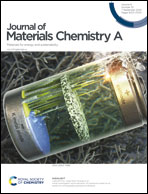Design and development of 3D hierarchical ultra-microporous CO2-sieving carbon architectures for potential flow-through CO2 capture at typical practical flue gas temperatures†
Abstract
Developing effective carbon materials for post-combustion CO2 capture (PCC) has received great attentions over many recent years, owing to their desirable adsorption–desorption performance and exceptional thermo-oxidative stability compared to virtually any other capture materials typically the wide array of amine-based sorbent materials. However, due to the nature of physical adsorption, virtually none of the carbon materials reported so far can be practically used for PCC applications without deep flue gas cooling to ambient or even lower temperatures in order to achieve appreciable levels of CO2 uptake capacities at low CO2 partial pressures. Here, we present a category of 3D hierarchical molecular sieving carbon architectures that are able to operate at realistic flue gas temperatures with exceedingly high reversible CO2 capacities. The breakthrough CO2-sieving carbon materials are prepared from using a cost-effective and commercially widely available precursor of polymeric polyisocyanurates with a facile one-step compaction–activation methodology. Tested at sensible flue gas temperatures of 40–70 °C and a low CO2 partial pressure of 0.15 bar, the best performing materials are found to have exceedingly high reversible CO2 capacities of up to 2.30 mmol g−1 at 40 °C and 1.90 mmol g−1 at 70 °C. Advanced characterisations suggest that the unique geometry and chemistry of the easily available precursor material coupled with the characteristics of the compaction–activation protocol used are responsible for the CO2-sieving structures and capacities of the 3D carbon architectures. The findings essentially change the general perception that carbon-based materials can hardly find applications in post-combustion capture due to their low CO2 uptake capacity at low CO2 partial pressures and realistic flue gas temperatures.



 Please wait while we load your content...
Please wait while we load your content...